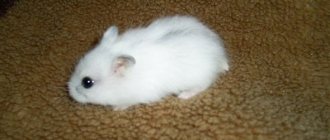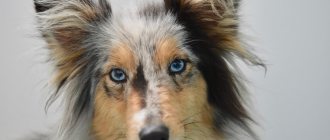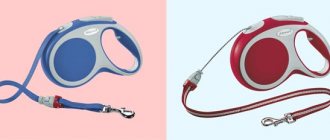Cheyletiellosis: what it is and modes of transmission
Obvious signs of cheyletiellosis are bald spots on the ears, neck, back, hairs do not hold well and fall out. The dog is constantly bothered by places where ticks accumulate; it scratches the affected areas vigorously, causing wounds, pustules and an inflammatory process.
The disease is also called “wandering dandruff”, since many scales and crusts form at the site of mite penetration. Skin changes pigmentation. Another name is “body louse.”
The disease is highly contagious, which means that contact cheyletiellosis spreads rapidly, especially in places where there are large concentrations of dogs and violations of the rules of hygiene and their maintenance. Theoretically, the tick is transmitted to humans, but according to statistics, in no more than 30% of cases, and it is necessary for the owner (care staff) to have long and close contact with the sick animal without protective equipment.
Characteristics of the pathogen
The disease is caused by the tick cheiletiella yascuri, which spends its entire life cycle on the dog. In the external environment, a sexually mature individual will “survive” no more than 10 days. On the skin without penetration into the deep layers of the epidermis, the tick goes through 6 stages of development:
- the female attaches the eggs to the hair, near the skin;
- after 3-4 days the larvae appear;
- a week later, protonymphs with 8 legs are formed;
- after 4-5 days - in deutonymph.
After another 5 days - the adult stage, then sexually mature individuals of different sexes live, reproduce and feed on the dog for 2 weeks.
Important! The full cycle of a tick is 21-35 days, this must be taken into account when treating a dog, since a single application is not always effective. Only adult individuals die, but eggs and larvae may remain, and cheyletiellosis will return again.
It is important that females can exist in the external environment for up to 10 days. In males the period is more modest, up to 2 days. If circumstances are favorable, ticks move to a new object and the life cycle repeats again.
With rare exceptions, a dog can only be a carrier of cheyletiellosis, and there are no external skin lesions on it. Occasionally, small patches of dandruff, which the owner mistakes for dirt or a metabolic disorder.
Helpful information.
Cheyletella are mites that are often confused with allergies. A very common insect that causes skin lesions that are usually identified as “allergies” is cheyletiella. These are mites that are not visible to the naked eye (they can only be seen under a microscope). They do not make passages under the skin; they live and parasitize on its surface. They are specifically canine, but those that live on rabbits and cats can also live on dogs; it is the latter that cause the most severe itching in dogs.
The main (visible) symptom of the lesion is flaking of the skin (dandruff). The skin of the back is most often affected. The severity of itching varies greatly among different animals. Sometimes very severe itching occurs, leading to self-injury.
Young dogs and animals with immunosuppression are predisposed to infection with cheyletella. That is, even if the dog has been walking all the time in an area infected with cheyletella, it can “not pick it up” as long as it has a strong immune system. As soon as the immunity weakens, the cheyletiella are right there - they will immediately “settle” in the dog. Now we are talking about a healthy dog that does not have any hereditary pathologies. So, the question is: when can immunity weaken? -During a change of teeth, for example. -During the dog’s illness with some other disease. -If any disease was treated with glucocorticosteroids (dexamethasone, prednisolone, cortisone, betamethasone, etc.) -If the dog was stressed. In this case, the body itself begins to produce corticoids, with all the ensuing consequences. Moreover, dandruff, the cause of which is precisely cheyletiella, is almost always “written off” by veterinarians who do not particularly bother with the thought process (and, unfortunately, there are a lot of them) as an allergy, and begin to prescribe the dog antiallergic drugs and, very often, corticosteroids... Ah, as can be seen from the above, corticosteroids cause a decrease in immunity (inhibit the body’s immune system), and therefore (if the dog already has cheyletiella) will contribute to the prosperity of these skin parasites... The worst thing is that for a while corticoids will actually relieve the itching, but then the dog will only get worse... And at the end of the “treatment”, which, naturally, will not help the dog, veterinarians make a “conclusion” that your dog is so sick that it is easier to euthanize it and not torture it... By the way, about these and other consequences of the use corticoid drugs (for example, the very popular Execan, which contains dexamethasone).
“The causative agent of the disease is ticks Cheyletiella vasguri, which belong to the phylum Arthropoda, class. Arachnida, neg. Acariformes; p/neg. Trombidiformes, n/sem. Cheyletoidea, fam. Cheyletidae, genus Cheyletiella. These are small oval-shaped mites. Their gnathosoma is clearly separated from the body, has the shape of a cone and has dense integument. On the sides of it there are large tentacles with five movably connected segments ending in claw-like outgrowths. The two pairs of forelimbs are somewhat distant from the two pairs of hind limbs. The tarsi of 1 pair of legs do not have claws. On the dorsal side of the body, females have one, and males have two, smooth trapezoidal shields. They are slightly chitinized and yellowish-white in color. The marginal setae are covered with hairs. Cheyletiellosis is characterized by seasonality - outbreaks are recorded in spring and autumn. Young dogs over 6 months of age and dogs with immunodeficiency are most often affected. Many sources indicate that the disease can be transmitted to humans. With cheyletiellosis, the skin of the back, possibly the groin, is usually affected, on which large “dandruff” appears, like flakes of dry skin, sometimes of quite a decent size. There is itching, the dog can chew quite hard.
Treatment: drops on the withers of Advocate or Stronghold (according to the dog’s weight) 2-3 times at intervals of 3 weeks. It is also necessary to treat all dogs and cats living with the sick animal with Stronghold (for cats - Feline Stronghold). You can treat the beds and apartment with preparations such as Butox, Neostomazan, etc. There is no need to treat the environment with anything - the tick does not live long without an animal; drops on the withers will be enough. (I would like to note that Stronghold is not a cheap drug, but trying to save money by replacing it with, for example, Frontline or Bars is useless. These drugs are ineffective against cheyletiella, relief will take many months, and in the meantime the dog will comb and chew. This will also have to be treated , buying all kinds of drugs. In general, you won’t get decent savings plus the animal’s suffering.) At the end of the course of treatment, the dog can be washed with shampoo, for example, “8 in 1 Anti-itching and dandruff,” or tar soap to wash off most of the scales. The remaining ones are completely combed out within about a month. Put on a parasite collar and wear it constantly. If, after completely cleansing the dog of “garbage”, after a short time the “dandruff” suddenly appears again - THIS IS NOT NORMAL! And it can only mean one thing – they weren’t treated enough. This means that the Stronghold treatment needs to be repeated.
Verification of the diagnosis of Heyletiella: scrape the skin, press clear adhesive tape to the affected area, then stick it to a glass slide and examine it under a microscope.
A dog affected by cheyletiellosis in an advanced form. ( on the picture)
“Flakes” appeared on the fur, probably a week (or even 2) after the treatment was started... At first there was dandruff on the dog, but it was just a little bit. These flakes are essentially a sign that the treatment is helping, but many people regard their appearance as the opposite, they believe that the dog has become worse... (the conclusion is drawn: “from the treatment”). Don't expect your dog to stop itching right away. On the contrary, at first after treatment it may begin to itch more; this is normal. And there may be more dandruff - this is also normal. The “itching” should stop only after about 3 weeks. And then, that is, 3-4 weeks, it must be re-treated. Before treatment, you can wash it to remove the “dandruff”; tar soap helps a lot. The Biafar collar must be worn constantly without taking it off. Just repeat once again - the collar should not be “Bio”. And although the instructions usually state that the collars will last for a very long time, in reality the collars are only effective for about a month. And then their effect begins to weaken. After about 2 months they are already completely ineffective...
The dog 2 months after treatment. Chow was cured not with the help of “rice diets”, treatments for “allergies”, “liver” and “fungi”, but with the help of only a thorough (and competent!) Treatment for skin parasites. Taken from https://ingrus.net/xejletielly.html
Symptoms of cheyletiellosis: how to recognize the disease
In English literature there is another name for the disease - “wandering dandruff”, so named for the characteristic ability of dry crusts to move throughout the body. By magnifying the observed area using a magnifying glass, you can also find the external parasites themselves.
During examination, a veterinary dermatologist at the RosVet VC notes:
- areas of alopecia (bald spots);
- excessive oily hair and skin;
- disheveledness, sometimes slight curliness;
- with extensive damage, the skin is inflamed, hyperemic, and hyperpigmented.
Itching of varying intensity forces the dog to scratch the affected areas, causing the formation of wounds and erosion. When bacterial microflora enters, the lesions become covered with pus.
Important! Paradoxically, the more carefully the owners take care of the dog, the more difficult it is to make a diagnosis. Since they literally wash away the clinical picture with water, shampoo or remove dandruff by combing.
How to correctly diagnose the disease
When making a diagnosis, it is necessary to differentiate cheyletiellosis from food allergies, dermatitis of various etiologies, seborrhea, metabolic disorders, etc. That is why the dog owner must contact a dermatologist at the RosVet EC. Treatment “at random” is unacceptable, since the spread of the tick is dangerous for other pets.
What must be excluded when making a diagnosis:
- staphylococcal pyoderma (nodules with pus, culture is done to identify staphylococcus);
- seborrhea (dandruff appears due to excessive production of sebum, accompanied by severe dry hair and an unpleasant odor);
- demodicosis (parasitization of demodex mites, scraping is done and the parasite is identified under a microscope);
- allergies (the provoking factor for a skin reaction can be any food, medicine, fleas, etc.; a blood test reveals an increased level of eosinophils);
- sarcaptosis (itching blisters, scratching with blood and a characteristic tilt of the head);
- pediculosis (detection of a skin parasite).
Cheyletiellosis can be detected without the use of special laboratory methods and devices. But it would be more effective to take a scraping, place a piece of skin on a glass slide and visualize the skin parasite.
Sometimes, when an accurate diagnosis is not possible, a trial dose of the drug Fipronil is used. If the reaction is positive and the number of severe symptoms decreases, we can talk about cheyletiellosis.
How do signs of the disease appear?
Please note that each type of scabies has its own set of symptoms. Although they coincide in basic features, they still have differences.
The extent of infection and symptoms will depend on:
- the number of ticks the pet received;
- immunity;
- age and chronic diseases.
Infection of an animal with cheyletiosis is accompanied by:
- itching;
- presence of dandruff;
- skin irritation;
- redness;
- hair loss in areas of infection.
The site of a tick bite is an area with raised skin scales. In places where it moves, flakes similar to dandruff are observed. But in reality these are ticks. If you look at them under a good magnifying glass, you can see movement.
Features of infection:
- the main area of infection is the back, along the ridge;
- Skin irritation and hair loss are minimal;
- Young puppies are more often infected due to an insufficiently strong immune system.
Important! If you are not sure what your dog is sick with, but see signs of infection
—
Be sure to visit a veterinarian for diagnosis and prescription of medications.
Treatment of the disease and prognosis
The owner of a dog with cheyletiellosis must provide conditions for isolating the pet from other pets, and also not have contact with pets on the street. In addition, you will need to disinfect the entire room and protect your own skin; cheyletiellosis can cause unpleasant itching, redness and the formation of a rash.
Hospital of the RosVet Exhibition Center
The ideal condition is to place the dog in the hospital of the RosVet VC for the duration of treatment. Pet care will be provided around the clock; specialists will promptly treat the affected areas of the skin and minimize the possibility of the tick spreading, as well as a re-outbreak of the disease.
The duration of treatment is up to 8 weeks; it is important not only to destroy current sexually mature individuals, but also to prevent their development from eggs, as well as the growth of larvae.
The drug is prescribed strictly by a veterinarian. Using medications on your own may not only fail to kill mites, but may also cause a negative reaction. Some of them are dangerous for dogs (note: ivermectin for collies).
If dandruff is detected in a timely manner and a visit to the veterinary clinic is carried out, treatment proceeds quickly, and the prognosis for the disease is favorable. If the dog has damaged large areas of the skin, there are scratches and a bacterial infection has developed - the therapy is complex and lengthy. Therefore, dermatologists at the RosVet EC advise not to let the disease progress, but to contact the clinic immediately.
If you suspect cheyletiellosis, do not hesitate, call 24/7 +, make an appointment with a dermatologist and bring your dog for an examination. Remember that treatment of any disease at the initial stage is much easier for the pet and less expensive for the owner.
Treatment of cheyletiellosis in dogs
Treatment for cheyletiosis begins with trimming your long-haired dog in areas where ticks are suspected to be present. This is a necessary measure, because This type of parasite attaches its eggs to the hairs using sticky saliva. Wipe the infected area of skin with Fipronil 0.25%. This should be done 2-3 times a week for 4 weeks. The drug will disinfect the skin, relieve inflammation and thus treat it.
Means and preparations
Cheyletiella is sensitive to most insecticides applied to the skin. Including anti-flea products. Therefore, the following drugs are used to treat cheyletiellosis in dogs: Ivermectin, Selamectin, Fipronil, Moxidetin. The product is used 2 times with an interval of 10 days. During this time, the ticks will have time to hatch from the eggs laid by the females, because Most drugs do not work on them.
To remove the results of ticks from your pet, you need to wash it thoroughly. In some cases, a bath is indicated 2 to 6 times.
Important! If it is not possible to wash dog bedding in a washing machine, then you can put it in a sealed bag for 10 days without access to oxygen. During this time, the ticks will die.
The purpose of bathing is to open the pores of the skin and identify mites, which need to be treated with a special medicine after bathing. Therefore, it is not necessary to use anti-flea shampoo for this procedure. The exception is drugs that can simultaneously act on ticks.
Preparation for the procedure:
- The acidity level of a dog's skin is 7.4 pH. The acidity level of the shampoo should be the same. For this reason, it is not recommended to wash it with a product for cats if its acidity is in the range of 3–6 pH.
- The pet is not fed before bathing.
- The water temperature should be no more than +35°C. Air temperature - not lower than +22°C.
- A rubberized mat is placed under the pet’s feet.
- The wool is combed to remove tangles.
- Before washing your dog, you need to wear a rubber apron and gloves.
- You also need to prepare towels, shampoo and snacks nearby.
Animals do not understand your purpose for washing.
But getting goodies is a very clear argument. Therefore, the dog must be rewarded after the procedure. Bathing instructions:
- Adjust the jet. It should flow slowly and be warm.
- Hold the animal and gently wet the fur with your hand. Tell him something and lather him, starting from the back, and then moving to the chest, paws, belly, tail.
- Massage the skin in areas where there are mites. You need to get them as close to the surface of the skin as possible.
- Now apply medicated shampoo. Continue massaging these areas. Shampoo soak time and dosage should be as directed on the label.
- Now rinse thoroughly.
- Wring the water out of the dog with a towel.
- Treat yourself to some well-deserved goodies.
Did you know? The Border Collie is considered the smartest of all dog breeds, followed by the Poodle and the German Shepherd. They understand and remember a vocabulary of 250 words.
Room treatment
Household decontamination is also required.
It will include the following steps:
- Vacuum carpets, furniture, drapes and mattresses.
- Wash floors 2 times a day with hot water and 50 ml of bleach or vinegar.
- Wash bedding in hot water at +50°C for 10 minutes. Dry on high heat.
- Control the humidity level in your home. At 50% humidity, scabies mites begin to die. Therefore, you should use a dehumidifier in the bathroom after washing or washing your pet.
- Anything that cannot be washed should be treated with hot steam or placed in the sun for 12 hours.










